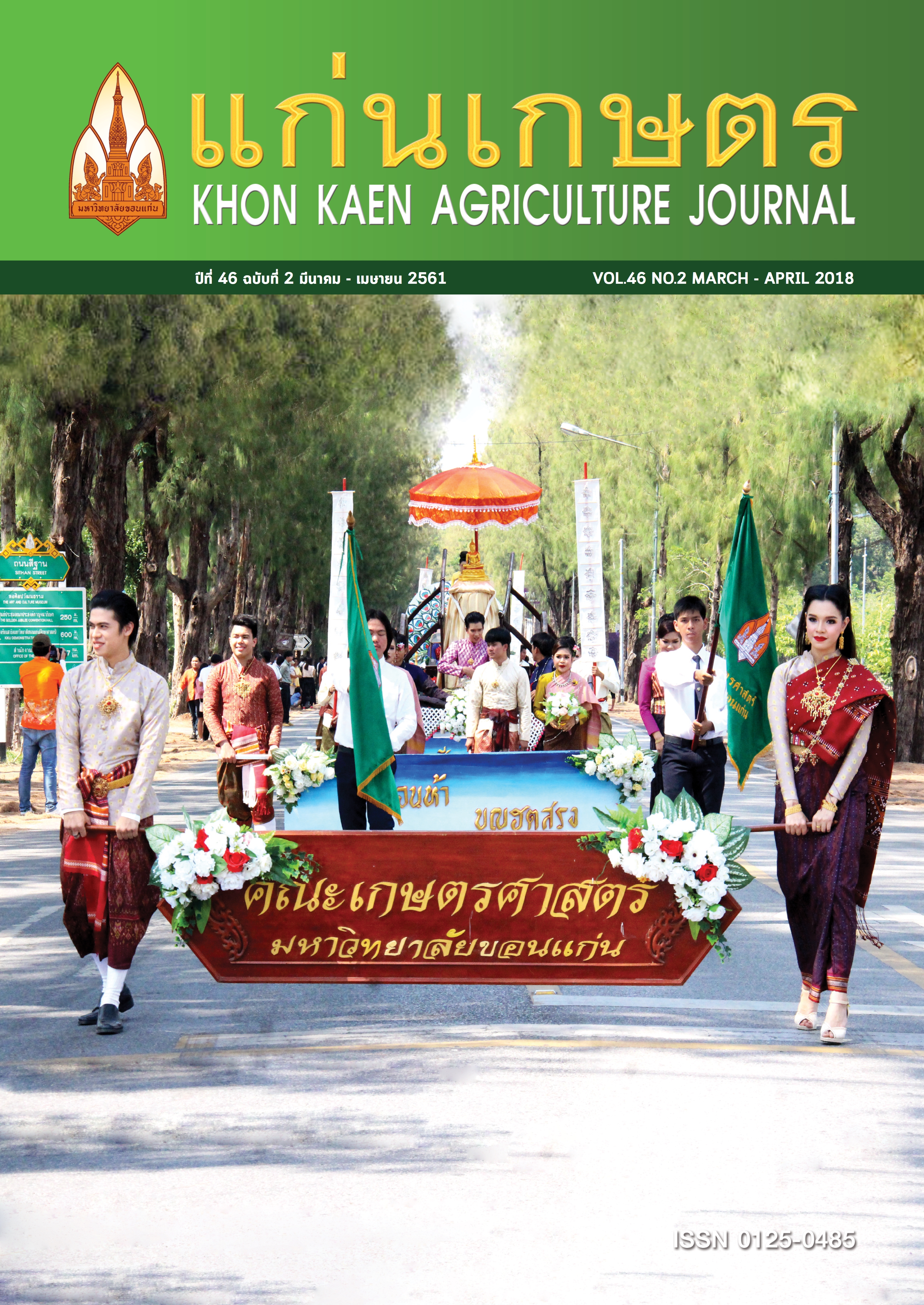ฤทธิ์ป้องกันดีเอ็นเอเสียหายของสารสกัดจากใบและลำต้นของสมุนไพรกรดน้ำที่สกัดด้วยตัวทำละลายชนิดต่างๆ
Main Article Content
บทคัดย่อ
งานวิจัยนี้มีวัตถุประสงค์เพื่อ ศึกษาฤทธิ์การป้ องกันดีเอ็นเอเสียหายจากอนุมูลอิสระ ของสารสกัดจากใบและลำต้นของสมุนไพรกรดน้ำที่สกัดด้วยตัวทำละลายชนิดต่างๆ 5 ชนิด คือ เมทานอล บิวทานอล เอทิลอะซีเตท คลอโรฟอร์ม และเฮกเซน พบว่าสารสกัดที่สกัดด้วยเมทานอล และบิวทานอล ซึ่งเป็นตัวทำละลายชนิดที่มีสภาพขั้วค่อนข้างสูง มีฤทธิ์ในการป้ องกัน supercoiled plasmid DNA เสียหายจากอนุมูลอิสระได้ ทั้งสารสกัดจากใบและลำต้น นอกจากนี้พบว่าสารสกัดจากใบที่สกัดด้วยเอทิลอะซีเตทและเฮกเซน สามารถป้ องกัน supercoiled plasmid DNA ได้เช่นเดียวกัน แต่อย่างไรก็ตาม สารสกัดจากส่วนลำต้นไม่สามารถป้ องกันความเสียหายต่อ supercoiled plasmid DNA ส่วนสารสกัดที่สกัดด้วยคลอโรฟอร์ม ในส่วนของสารสกัดจากใบ ไม่สามารถป้ องกันความเสียหายของ supercoiled plasmid DNA ได้ ส่วนสารสกัดจากลำต้นสามารถป้ องกันดีเอ็นเอเสียหายได้ นอกจากนี้พบว่าสารสกัดที่ความเข้มข้น 3 mg/ml จะชักนำการทำลายดีเอ็นเอได้อีกด้วย นอกจากการศึกษาฤทธิ์ต้านอนุมูลอิสระของสารสกัดจากต้นกรดน้ำแล้ว การศึกษาในครั้งนี้ยังแสดงให้เห็นว่า วิธี DNA nicking assay สามารถปรับใช้กับสารสกัดที่สกัดด้วยตัวทำละลายหลากหลายชนิดได้
Article Details
เอกสารอ้างอิง
วัชรีพร คงวิลาด. 2543. เมื่อคุณเป็นโรคเบาหวานสมุนไพรและพืชพื้นบ้านช่วยคุณได้. เกษตรกรรมธรรมชาติ. 8.
Adaikpoh, M. A., N.E.J. Orhue, and I. Igbe. 2007. The protective role of Scoparia dulcis on tissue antioxidant defense system of rats exposed to cadmium. Afr. J. Biotechnol. 10: 1192-1196.
Coulibaly, A.Y., P.A.E.D. Sombie, A. Tibiri, M. Kiendrebeogo, M.M.Y. Compaore, and O.G. Nacoulma. 2011. Protective Effect of Scoparia dulcis on Brain and Erythrocytes. Curr. Res. J. Biol. Sci. 3: 254-261.
Coulibaly, A.Y., K. Konate, P.A. Sombie, M. Kiendrebeogo, N.T.R. Meda, A. Lamien, B. Zeba, and O.G. Nacoulma. 2012. Anti-proliferative effect of Scoparia dulcis L. against bacterial and fungal strains. IJBCS. 6: 3055-3063.
Flemmig, J., and J. Arnhold. 2007. Ferrous ion-induced strand breaks in the DNA plasmid pBR322 are not mediated by hydrogen peroxide. Eur. Biophys. J. 36: 377-384.
Golla, U., and S.S.R. Bhimathati. 2014. Evaluation of antioxidant and DNA damage protection activity of the hydroalcoholic extract of Desmostachya bipinnata L. Stapf. Scientific. World. J. Available: https://goo.gl/sB7jdh. Accessed Oct. 15, 2017.
Jackson, S.P., and J. Bartek. 2009. The DNA-damage response in human biology and disease. Nature. 7267: 1071-1078.
Kong, E.-L., B.-K. Lee, Michelle, I. Ginjom, and P.M. Nissom. 2015. DNA damage inhibitory effect and phytochemicals of fermented red brown rice extract. Asian. Pac. J. Trop. Biomed.9: 732-736.
Leba, L.J., C. Brunschwig, M. Saout, K. Martial, E. Vulcain, D. Bereau, and J.C. Robinson. 2014. Optimization of a DNA nicking assay to evaluate Oenocarpus bataua and Camellia sinensis antioxidant capacity. Int. J. Mol. Sci. 15: 18023-18039.
Lu, L.Y., N. Ou, and Q.B. Lu. 2013. Antioxidant induces DNA damage, cell death and mutagenicity in human lung and skin normal cells. Scientific reports. 3: 3169.
Nimse, S.B., and D. Pal. 2015. Free radicals, natural antioxidants, and their reaction mechanisms. RSC Advances. 5: 27986-28006.
Pari, L., and M. Latha. 2005. Antidiabetic effect of Scoparia dulcis: effect on lipid peroxidation in streptozotocin diabetes. Gen. Physiol. Biophys. 24: 13-26.
Saelee, N., M. Tonganunt-Srithaworn, W. Wanna, and A. Phongdara. 2011. Receptor for Activated C Kinase-1 protein from Penaeus monodon (Pm-RACK1) participates in the shrimp antioxidant response. Int. J. Biol. Macromol. 1: 32-36.
Sharma, S., S. Sharma, and A.P. Vig. 2016. Evaluation of antimutagenic and protective effects of Parkinsonia aculeata L. leaves against H2O2 induced damage in pBR322 DNA. Physiol. Mol. Biol. Plants. 1: 17-31.
Tsai, J.C., W.H. Peng, T.H. Chiu, S.C. Lai, and C.Y. Lee. 2011. Antiinflammatory effects of Scoparia dulcis L. and betulinic acid. Am. J. Chin. Med. 39: 943-956.
Verma, A.R., M. Vijayakumar, C.S. Mathela, and C. V. Rao. 2009. In vitro and in vivo antioxidant properties of different fractions of Moringa oleifera leaves. Food. Chem. Toxicol. 47: 2196-2201.
Wankhara, W., S. Srinivasana, and S. Rathinasamy. 2015. HPTLC analysis of Scoparia dulcis Linn (Scrophulariaceae) and its larvicidal potential against dengue vector Aedes aegypti. Nat. Prod. Res. 29(18): 1757-1766.
Zhu, L., J. Chen, J. Tan, X. Liu, and B. Wang. 2017. Flavonoids from Agrimonia pilosa Ledeb: Free radical scavenging and DNA oxidative damage protection activities and analysis of bioactivity-structure relationship based on molecular and electronic structures. Molecules. 22(3)pii: E195.
Zulfiker, A. H. M., M. Siddiqua, L. Nahar, M.R. Habib, N. Uddin, N. Hasan, and M.S. Rana. 2011. In vitro antibacterial, antifungal and cytotoxic activity of Scoparia dulcis L. J. Pharm. Pharm. Sci. 2: 198-203.


